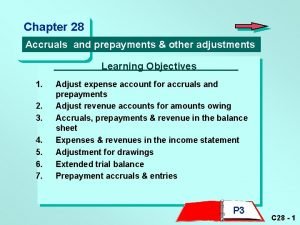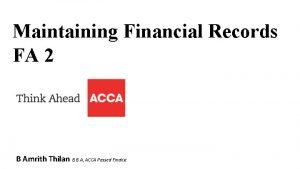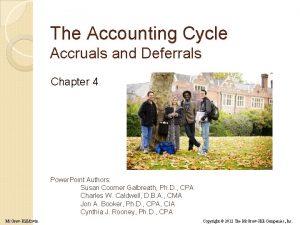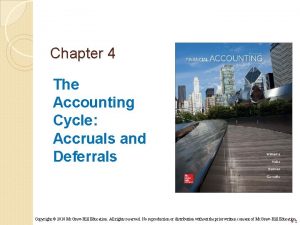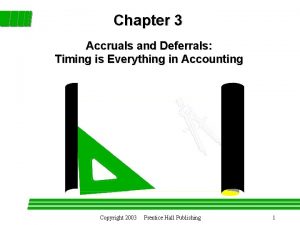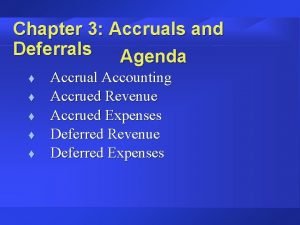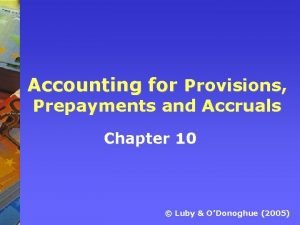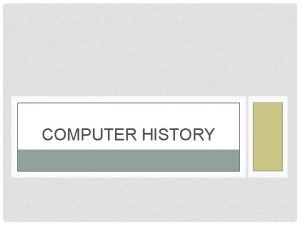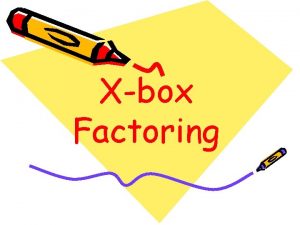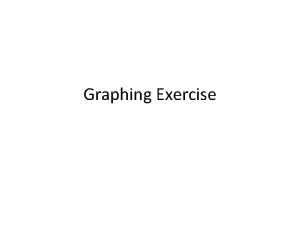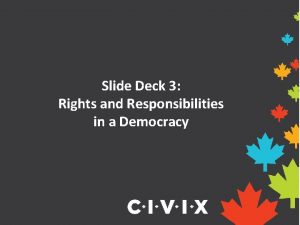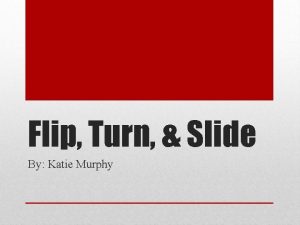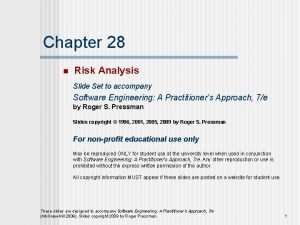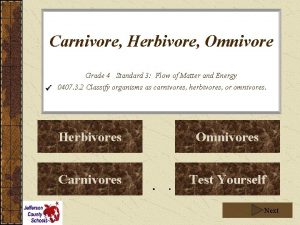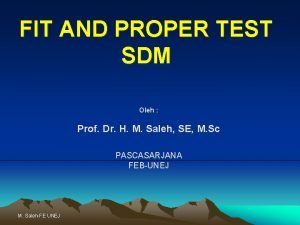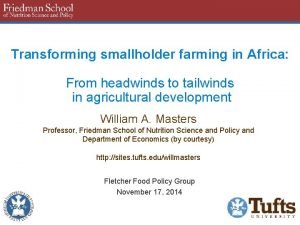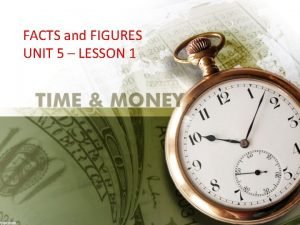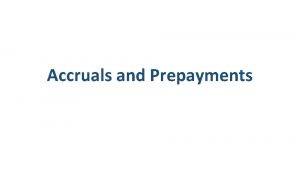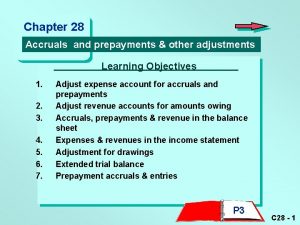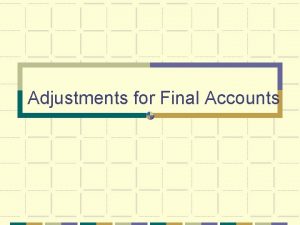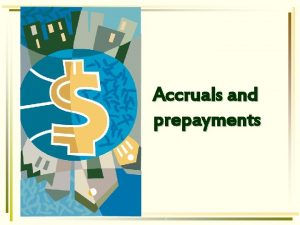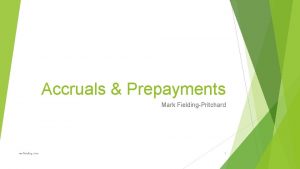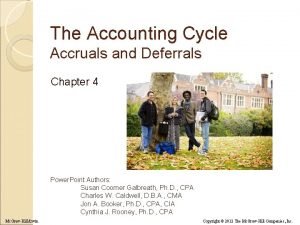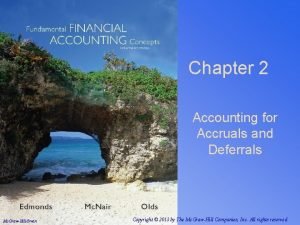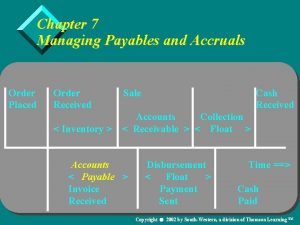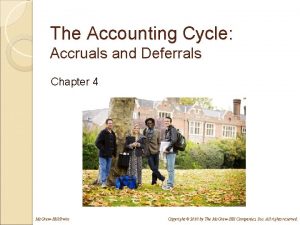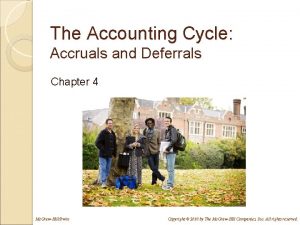Slide 28 1 Chapter 28 Accruals and prepayments



























- Slides: 27

Slide 28. 1 Chapter 28 Accruals and prepayments and other adjustments for financial statements Frank Wood and Alan Sangster , Frank Wood’s Business Accounting 1 , 12 th Edition, © Pearson Education Limited 2012

Slide 28. 2 Learning objectives After you have studied this chapter, you should be able to: Ø Adjust expense accounts for accruals and prepayments Ø Adjust revenue accounts for amounts owing Ø Show accruals, prepayments and revenue accounts receivable in the statement of financial position Frank Wood and Alan Sangster , Frank Wood’s Business Accounting 1 , 12 th Edition, © Pearson Education Limited 2012

Slide 28. 3 Learning objectives (Continued) Ø Ascertain the amounts of expense and revenue items to be shown in the income statement after making adjustments for accruals and prepayments Ø Make the necessary end-of-period adjustments relating to drawings that have not yet been entered in the books Frank Wood and Alan Sangster , Frank Wood’s Business Accounting 1 , 12 th Edition, © Pearson Education Limited 2012

Slide 28. 4 Learning objectives (Continued) Ø Explain what an extended trial balance is and describe what it looks like Ø Prepare accrual and prepayment entries to the accounts using two different methods Frank Wood and Alan Sangster , Frank Wood’s Business Accounting 1 , 12 th Edition, © Pearson Education Limited 2012

Slide 28. 5 The financial statements Ø The financial statements need to contain the expenditure relating to the period. Ø Therefore, if expenditure is owing or has been overpaid, an adjustment is needed. Frank Wood and Alan Sangster , Frank Wood’s Business Accounting 1 , 12 th Edition, © Pearson Education Limited 2012

Slide 28. 6 The financial statements (Continued) Example – Two businesses are renting buildings and are charged £ 6, 000 per year. Business A pays £ 5, 000 in the year. It therefore owes £ 1, 000, but the rent expense in the income statement must be shown as £ 6, 000. Business B pays £ 6, 500 in the year. It has therefore overpaid £ 500, but the rent expense in the income statement must be shown as £ 6, 000. Frank Wood and Alan Sangster , Frank Wood’s Business Accounting 1 , 12 th Edition, © Pearson Education Limited 2012

Slide 28. 7 Accrued expenses Rent of £ 4, 000 per year as payable at the end of every three months. The rent was paid on time in March, but this is not always the case. Frank Wood and Alan Sangster , Frank Wood’s Business Accounting 1 , 12 th Edition, © Pearson Education Limited 2012

Slide 28. 8 Accrued expenses (Continued) The rent for the last quarter was paid on 5 January, which is after year end, so the books will appear as: Frank Wood and Alan Sangster , Frank Wood’s Business Accounting 1 , 12 th Edition, © Pearson Education Limited 2012

Slide 28. 9 Accrued expenses (Continued) The true rent figure for the year must be shown in the profit and loss account Frank Wood and Alan Sangster , Frank Wood’s Business Accounting 1 , 12 th Edition, © Pearson Education Limited 2012

Slide 28. 10 Accrued expenses (Continued) The accrued rent expense must be shown on the rent account Frank Wood and Alan Sangster , Frank Wood’s Business Accounting 1 , 12 th Edition, © Pearson Education Limited 2012

Slide 28. 11 Prepaid expenses Insurance for a business is at the rate of £ 840 a year, starting from 1 January 2011. The business has agreed to pay this at the rate of £ 210 every three months. However, payments were not at the correct times. Frank Wood and Alan Sangster , Frank Wood’s Business Accounting 1 , 12 th Edition, © Pearson Education Limited 2012

Slide 28. 12 Prepaid expenses (Continued) The insurance has been paid at odd times, and so when the correct figure is taken to the profit and loss account, the books will appear as: Frank Wood and Alan Sangster , Frank Wood’s Business Accounting 1 , 12 th Edition, © Pearson Education Limited 2012

Slide 28. 13 Prepaid expenses (Continued) The prepaid insurance expense must be shown on the insurance account: Frank Wood and Alan Sangster , Frank Wood’s Business Accounting 1 , 12 th Edition, © Pearson Education Limited 2012

Slide 28. 14 Revenue owing at the end of period Revenue owing for sales is already shown in the books as the debit balances on customers’ accounts but there may be other kinds of revenue which may not have been received at the end of the period. Frank Wood and Alan Sangster , Frank Wood’s Business Accounting 1 , 12 th Edition, © Pearson Education Limited 2012

Slide 28. 15 Revenue owing at the end of period (Continued) Our warehouse is larger than we need and so we rent part of it to another business for £ 1, 800 per annum. Frank Wood and Alan Sangster , Frank Wood’s Business Accounting 1 , 12 th Edition, © Pearson Education Limited 2012

Slide 28. 16 Revenue owing at the end of period (Continued) The rent receivable account will appear as: Frank Wood and Alan Sangster , Frank Wood’s Business Accounting 1 , 12 th Edition, © Pearson Education Limited 2012

Slide 28. 17 Revenue owing at the end of period (Continued) Once the correct figure has been transferred to the profit and loss account, the accrued revenue must be shown in the rent receivable account: Frank Wood and Alan Sangster , Frank Wood’s Business Accounting 1 , 12 th Edition, © Pearson Education Limited 2012

Slide 28. 18 The statement of financial position The part of the statement of financial position in respect of the accounts so far seen is therefore: Frank Wood and Alan Sangster , Frank Wood’s Business Accounting 1 , 12 th Edition, © Pearson Education Limited 2012

Slide 28. 19 Expense accounts covering more than one period Ø It is more likely that there will be opening accruals and prepayments on an account. Ø This really tests your knowledge of double entry bookkeeping and you will have to distinguish between accruals and prepayments and the beginning and the end of the year. Frank Wood and Alan Sangster , Frank Wood’s Business Accounting 1 , 12 th Edition, © Pearson Education Limited 2012

Slide 28. 20 Activity (A) On 31 December 2010, three months’ rent amounting to a total of £ 3, 000 was owing. (B) The rent chargeable per year was £ 12, 000. (C) The following rent payments were made in the year 2011: 6 January, £ 3, 000; 4 April, £ 3, 000; 7 July, £ 3, 000; 18 October, £ 3, 000. (D) The final 3 months’ rent for 2011 is still owing. Frank Wood and Alan Sangster , Frank Wood’s Business Accounting 1 , 12 th Edition, © Pearson Education Limited 2012

Slide 28. 21 Activity (Continued) Frank Wood and Alan Sangster , Frank Wood’s Business Accounting 1 , 12 th Edition, © Pearson Education Limited 2012

Slide 28. 22 Goods for own use Ø To record a trader taking goods for their own use: Debit drawings, credit purchases Ø If there is a VAT content to the goods: Debit drawings, credit VAT Ø If the business has paid for a personal transaction: Debit drawings, credit the relevant account Frank Wood and Alan Sangster , Frank Wood’s Business Accounting 1 , 12 th Edition, © Pearson Education Limited 2012

Slide 28. 23 Extended trial balances Ø An extended trial balance is a worksheet for drafting a set of financial statements. Ø It is very useful when there a lot of adjustments to be made. Ø The trial balance is extracted from the ledgers and the adjustments are made against this. Ø The financial statements are then worked out across the page. Frank Wood and Alan Sangster , Frank Wood’s Business Accounting 1 , 12 th Edition, © Pearson Education Limited 2012

Slide 28. 24 An extended trial balance Frank Wood and Alan Sangster , Frank Wood’s Business Accounting 1 , 12 th Edition, © Pearson Education Limited 2012

Slide 28. 25 Learning outcomes You should have now learnt: 1. That adjustments are needed so that the expenses and income shown in the financial statements equal the expenses incurred in the period and the revenue that has arisen in the period 2. That the balances relating to the adjustments will be shown on the statement of financial position at the end of the period as current assets and current liabilities Frank Wood and Alan Sangster , Frank Wood’s Business Accounting 1 , 12 th Edition, © Pearson Education Limited 2012

Slide 28. 26 Learning outcomes (Continued) 3. That goods taken for the owner’s own use without anything being recorded in the books will necessitate a transfer from purchases to the drawings account, plus an adjustment for VAT if appropriate 4. How to record appropriate entries in the accounts and financial statements at the end of a period for accrued expenses, prepaid expenses, accrued income and drawings Frank Wood and Alan Sangster , Frank Wood’s Business Accounting 1 , 12 th Edition, © Pearson Education Limited 2012

Slide 28. 27 Learning outcomes (Continued) 5. That private expenses should not be charged as an expense in the income statement, but should be charged to the drawings account 6. That an extended trial balance is an alternative way of arriving at the figures to be included in the financial statements 7. That there are two common ways to prepare accruals and prepayments Frank Wood and Alan Sangster , Frank Wood’s Business Accounting 1 , 12 th Edition, © Pearson Education Limited 2012
 Accrued expenses meaning
Accrued expenses meaning Acca accruals and prepayments
Acca accruals and prepayments Heel and toe polka dance
Heel and toe polka dance Chapter 4 the accounting cycle accruals and deferrals
Chapter 4 the accounting cycle accruals and deferrals Chapter 4 the accounting cycle accruals and deferrals
Chapter 4 the accounting cycle accruals and deferrals Accruals and deferrals
Accruals and deferrals Accruals and deferrals
Accruals and deferrals Accruals concept
Accruals concept Slide and divide method
Slide and divide method Slip slide and collide
Slip slide and collide Sweep and prune collision detection
Sweep and prune collision detection Abacus invention date
Abacus invention date Slip and slide method factoring
Slip and slide method factoring Identifying qualitative graphs
Identifying qualitative graphs Roles and responsibilities slide
Roles and responsibilities slide Rhinoceros omnivore carnivore herbivore
Rhinoceros omnivore carnivore herbivore Translation slide
Translation slide Roles and responsibilities slide
Roles and responsibilities slide Mangahigh transtar
Mangahigh transtar Risks and mitigation slide
Risks and mitigation slide Dugong herbivore or omnivore
Dugong herbivore or omnivore Presentasi fit and proper test
Presentasi fit and proper test Headwinds and tailwinds slide
Headwinds and tailwinds slide Facts and figures slide
Facts and figures slide Chapter 7 ionic and metallic bonding chapter answer key
Chapter 7 ionic and metallic bonding chapter answer key Chapter 7 ionic and metallic bonding assessment answer key
Chapter 7 ionic and metallic bonding assessment answer key Ionic compound properties
Ionic compound properties 7 ionic and metallic bonding practice problems
7 ionic and metallic bonding practice problems
